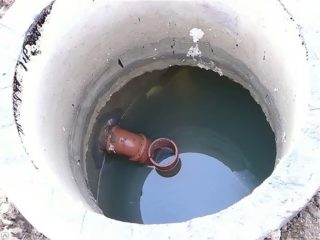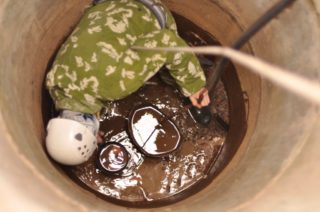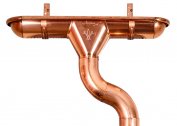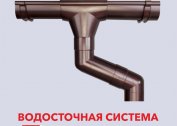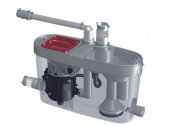Autonomous sewage is a private pipeline and the final point of sewage (pit, septic tank). This tank must be periodically cleaned of accumulated sewage. Pumping of sewer pits / septic tanks can be performed in one of the ways convenient for the master. Which one to choose, the owner of the site decides, depending on the availability of free time, funds and the desire to tinker with drains.
The need for periodic pumping of cesspools
A properly designed sewage receiver is fully filled approximately every 3-4 months. At the same time, the level of waste in the pit also depends on such parameters:
- The amount of sludge at the bottom, the walls of the tank (for leaking receivers). If they are fairly covered with fecal fat polyps, water will be drawn into the pit faster.
- The intensity of the use of sewage (guests arriving, added washing equipment, etc.).
Each master should be aware of the need for timely cleaning / pumping of the tank under wastewater. If you do not do this on time, the following problems may occur:
- Failure of special filters, if they were installed during the installation of the collector.
- Stagnation of dirty water in the sewer, its slow outflow. Sometimes even fecal discharges into the toilet or sink / bathtub can occur. From this, growths of fatty polyps are not excluded on the walls of sewer pipes. As a result, the system will have to be thoroughly flushed to return the collector to its previous diameter.
- Overflowing waste outside the pit, which will provoke an environmental disaster. Fecal runoff can seep into groundwater and reach drinking wells. This could trigger an epidemic of infectious diseases among residents of the region.
- Reproduction of pathogenic bacteria and, as a result, excessive stench on the site. A cesspool ambre is a mixture of methane gas, ammonia and hydrogen sulfide. In this combination, they cause irreparable harm to human health. In particular, they affect the central nervous system, respiratory organs.
- Poisoning of the soil due to overflow of runoff into it and the inability to plant crops in the ground. In addition, from such land it is impossible to collect and consume a crop of already sprouted plants for at least 3-4 years.
To avoid problems, you need to regularly clean the cesspool, constantly monitor the level of fecal water in it.
Effective ways to pump out the drain pit
There are several ways to remove impurities from a receiver in a suburban area. Each of them has its pros and cons.
Work of sewer equipment
This method is considered the most advanced. A special machine with a tank of several m3 drives up to the receiver. The equipment is equipped with a powerful pump that pumps large volumes of sewage in literally half an hour. In most cases, specially trained people operate the machine - employees of the company engaged in the pumping and disposal of sewage. Cleaning the cesspool with the help of a scavenger has several advantages:
- High speed of the process. Just 30 minutes and your receiver is ready to go again.
- Removing even old silt deposits from the tank.
- The driver / company must have a special permit for the export and disposal of wastewater to special municipal wastewater treatment plants, landfills, etc.
- The correct utilization of fecal matter and other household waste in terms of sanitary and epidemiological standards.
- An opportunity to conclude a long-term contract with the company Such relationships allow the owner of the site to rely on a range of services for a lower price (washing the pit, bonus brigade departure, etc.).
- Pumping out of fecal / household drains at any temperature indicators. Even with a strong minus.
But even such a modern technique for cleaning the sewer receiver has some disadvantages:
- Moderate noise in the operation of the machine. This should be taken into account if the neighbors react poorly to external stimuli (small child, sick parents, etc.).
- The need to ensure the access of the car to the pit. If this is not possible (for example, the collector is located in the far zone of the site) pump out the cesspools with a long hose. But here you have to pay extra for each meter of sleeve.
- Financial expenses. They are quite justified if the pit is working properly and it is necessary to clean it no more often than every 2-4 months. If everything is not all right with the receiver, the landlord can significantly spend money on the services of a sewage machine.
When ordering a machine, ask if the operator has a special permit for the removal and disposal of effluents in communal VOCs. Otherwise, an unscrupulous driver may dump waste into the nearest ditch or even a pond.
Pumping a hole using a fecal drainage pump
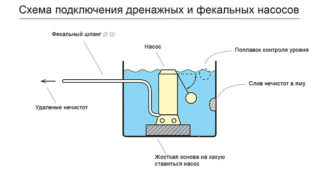 This method of removing domestic wastewater from the sewer is good if the owner of the site has the necessary equipment and the pit volume is no more than 3 m3. It is desirable that the pump has a special built-in chopper (cutting mechanism). He copes with large inclusions in water, turning them into a homogeneous mass. The advantages of such a pumping sewer receiver are as follows:
This method of removing domestic wastewater from the sewer is good if the owner of the site has the necessary equipment and the pit volume is no more than 3 m3. It is desirable that the pump has a special built-in chopper (cutting mechanism). He copes with large inclusions in water, turning them into a homogeneous mass. The advantages of such a pumping sewer receiver are as follows:
- Independence from third-party masters who may not arrive on holidays or later / earlier, but convenient time for the owner of the house. Work can be done when you want.
- Saving the family budget.
However, this method also has disadvantages. All drains removed from the pit must be pumped out into a sealed tank and then forwarded to them for disposal. This implies the need for such tanks (cubes / tanks) and personal vehicles. Accordingly, transportation costs will have to be borne.
The most important thing is the ban on the discharge of effluents into ravines, ditches, ponds. All sewage needs to be pumped out and then delivered only to specialized treatment plants. To do this, you have to conclude an agreement with them.
DIY wastewater treatment
If the pit is small (1 m3) and it just has water without fecal impurities, you can remove it yourself with a simple bucket. In the presence of waste from the toilet in the pit, biologics are pre-poured into it, which decompose effluents into water and organic sludge. The disposal of such waste must be carried out in protective clothing. Positive aspects of self-cleaning pit:
- complete family savings;
- compliance with sanitary standards when discharging clarified water into the ground;
- lack of stench over the site for the period of pumping the sewer receiver.
Of the minuses of such work, there are:
- The complexity of the process, even with a small volume of the pit.
- The need for disposal / storage of organic sludge until spring. He needs to be kept somewhere.
- Inability to use bacteria in winter. At low temperatures, they simply do not work. Bacteria carry out their activity at least at +5 degrees. If chemicals are used for sewage treatment, it is forbidden to pour such water into the ground.
Work using buckets and rope is preferred by few. To facilitate the task, you can combine the use of bacteria and the use of a drain pump in the future. With it, you can pump out and dump clarified water into the nearest ravine or water the garden with it.
Service cost
The price of services for pumping septic tanks and cesspools in the Moscow region starts at 360 rubles. The total cost of operation of the scavenger machine depends on the following parameters:
- volume of a cesspool;
- the number of hours of work / car visits;
- the need to finish the length of the cesspool;
- difficulty accessing the tank.
Sometimes the companies providing these services include in the cost of the work the payment of the distance that the car needs to travel from the city to its destination. It is advisable to clarify this issue when ordering a service.
